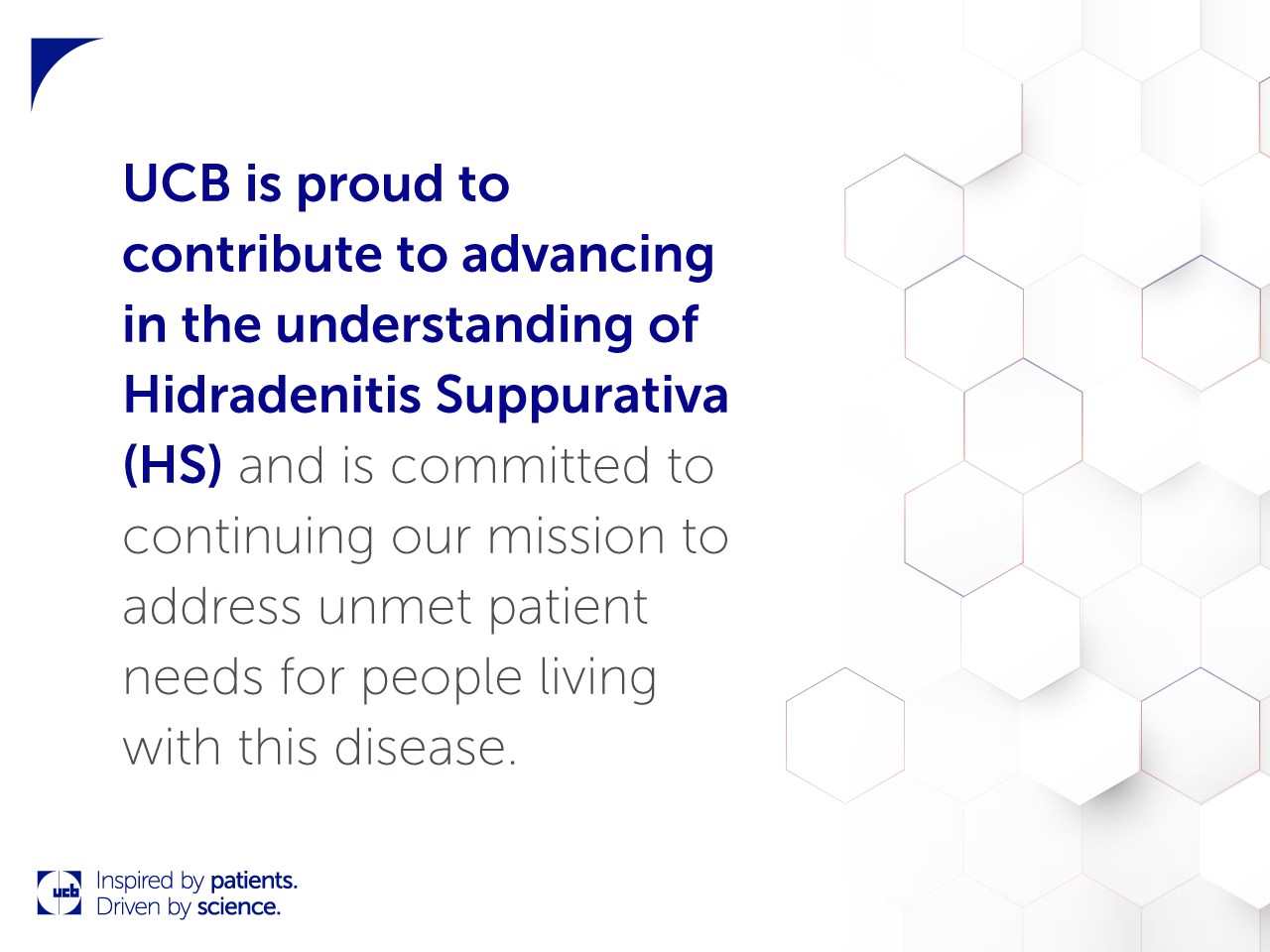
At UCB, people are at the heart of everything we do, and part of our commitment to delivering impactful solutions for people whose lives have been challenged by severe disease is deeply understanding their disease. This week is Hidradenitis Suppurativa (HS) Awareness Week, and we’re sharing information on this chronic, recurring, painful, and debilitating inflammatory skin disease.1,2
What is Hidradenitis Suppurativa?
Hidradenitis Suppurativa (HS), pronounced hidra-den-eye-tis sup-RA-tiva, is a burdensome immune-mediated inflammatory disease. The main symptoms of HS are nodules, abscesses, and tunneling (channels connecting with each other and leading out of the skin) which typically occur in the armpits, groin and buttocks.1,2 Most active disease occurs in young adulthood, and HS is hereditary in nearly 1 out of 3 cases.2,3 HS also disproportionately impacts African Americans and female patients.4 It is often misdiagnosed for diseases like acne.5 Because HS is visible to the eye, patients often report feeling uncomfortable in their own skin.6
How does HS impact patients?
HS is a progressive disease with unpredictable flare-ups that can occur every few weeks or months. Nearly 75% of people living with HS experience flares at least weekly, characterized by intensified inflammatory symptoms, including pain, discharge and itching.7 The symptoms often prevent people from participating in everyday activities like going to work or school.3 But this disease is more than skin deep.
In addition to the physical impact of HS, a recent survey showed a high frequency of mental health illnesses among people living with HS.6 People living with HS often feel self-conscious about the smell of draining abscesses and fear others’ reactions to their condition, which may be mistaken as a sexually transmitted disease.6 The stigma associated with the disease often prevents people living with HS from seeking out a health professional and can exacerbate social isolation.6
How is HS diagnosed and treated?
There is no definitive test for HS. Instead, healthcare providers will examine the site and type of lesions, monitor for reoccurrence, and have a thorough discussion of family and medical history. The average time from symptom onset to HS diagnosis is 10 years with more than 3 misdiagnoses along the way. The delay in diagnosis can result in the disease progressing to more severe HS, particularly for patients with aggressive progression.8 The long journey to diagnosis can also worsen mental health symptoms.6
We are proud to contribute to advancing in the understanding of HS and are committed to continuing our mission to address unmet patient needs for patients living with this disease.
- Lee, Erika Yue et al. “What is hidradenitis suppurativa?” Canadian family physician Medecin de famille canadien vol. 63,2 (2017): 114-120.
- Ingram JR. The epidemiology of hidradenitis suppurativa. Br J Dermatol. 2020 Dec;183(6):990-998. doi: 10.1111/bjd.19435. Epub 2020 Sep 3. PMID: 32880911.
- Vinkel C et al. Hidradenitis Suppurativa: Causes, Features, and Current Treatments. J Clin Aesthet Dermatol. 2018 Oct;11(10):17-23. Epub 2018 Oct 1. PMID: 30519375; PMCID: PMC6239161.
- Garg A, Kirby JS, Lavian J, Lin G, Strunk A. Sex- and age-adjusted population analysis of prevalence estimates for hidradenitis suppurativa in the United States. JAMA Dermatol. 2017;153(8):760-764.
- Esmann S, Jemec GB. Psychosocial impact of hidradenitis suppurativa: a quality study. Acta Derm Venereol. 2011; 91: 328-32.
- Shukla N, Paul M, Halley M, et al. Identifying barriers to care and research in hidradenitis suppurativa: findings from a patient engagement event. Br J Dermatol. 2020;182(6):1490-1492. doi:10.1111/bjd.18818
- Sarfo, A, Butt, M and Kirby, J. Periodic worsening, or flare, in hidradenitis suppurativa: the perspective of people with hidradenitis. Br J Dermatol. 2020;182:218-219.
- Kokolakis G, Wolk K, Schneider-Burrus S, et al. Delayed diagnosis of hidradenitis suppurativa and its effect on patients and healthcare system. Dermatology. 2020;236(5):421-430.
©2023 UCB, Inc., Smyrna, GA 30080. All rights reserved.
US-P-DA-RH-2200010
Choose Country
- Global Site – English
- Australia – English
- België – Engels
- Belgique – Anglais
- Brasil – Português
- България – Български
- Canada – English
- Canada – Français
- 中国 – 中文
- Česká Republika – Angličtina
- Danmark – Engelsk
- Deutschland – Deutsch
- France – Français
- España – Español
- Ελλάδα – Ελληνικά
- India – English
- Ireland – English
- Italia – Inglese
- 日本 – 日本語
- Казахстан – ағылшын тілі
- 한국 – 한국어
- Luxembourg – Anglais
- Luxemburg – Engels
- Magyarország – Angol
- México & Latinoamérica – Español
- Nederland – Engels
- New Zeeland – English
- Norge – Engelsk
- Österreich – Deutsch
- Polska – Polski
- Portugal – Inglês
- România – Engleză
- Россия – Русский
- Slovensko – Anglický
- Suomi – Englanti
- Sverige – Engelska
- Schweiz – Deutsch
- Suisse – Français
- Türkiye – Türkçe
- Україна – Англійська
- United Kingdom – English
- U.S.A. – English


